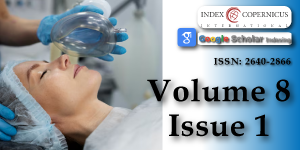An Instance of Green-tinted Urine Related to the use of Propofol
Main Article Content
Abstract
Urine typically has an amber-yellow color due to the amorphous pigment urochrome, a distinct scent, and an average pH of 6.0, which is somewhat acidic. Green urine can result from drug intake, dyes, infections, adverse drug reactions, and other causes. Less than 1% of propofol users experience green urine, a rare and benign side effect. The green tint in urine is caused by the phenolic metabolites of propofol. In this case, a 33-year-old man diagnosed with organophosphorus poisoning and aspiration pneumonia had been given a modest dose of propofol sedation for six hours and began to exhibit green urine. After five hours of halting the propofol infusion, the urine returned to its usual color. Healthcare practitioners should be aware of this unusual but safe side effect of propofol.
Article Details
Copyright (c) 2024 Maharjan B, et al.

This work is licensed under a Creative Commons Attribution 4.0 International License.
Shim YS, Gil HW, Yang JO, Lee EY, Kim SH, Hong SY. A case of green urine after ingestion of herbicides. Korean J Intern Med. 2008;23(1):42-44. Available from: https://doi.org/10.3904/kjim.2008.23.1.42 DOI: https://doi.org/10.3904/kjim.2008.23.1.42
Bowling P, Belliveau RR, Butler TJ. Intravenous medications and green urine. JAMA. 1981;246(3):216. Available from: https://pubmed.ncbi.nlm.nih.gov/7241760/ DOI: https://doi.org/10.1001/jama.1981.03320030014016
Bodenham A, Culank LS, Park GR. Propofol infusion and green urine. Lancet. 1987;2(8561):740. Available from: https://doi.org/10.1016/s0140-6736(87)91097-x DOI: https://doi.org/10.1016/S0140-6736(87)91097-X
Callander CC, Thomas JS, Evans CJ. Propofol and the color green. Anesthesia. 1989;44(1):82. Available from: https://doi.org/10.1111/j.1365-2044.1989.tb11141.x DOI: https://doi.org/10.1111/j.1365-2044.1989.tb11141.x
Gonenavar MM, Shukla S, Sridhar T, Prasad R, Tabali R. An unusual instance of propofol-triggered green urine in anesthesia management: A case report. MGM J Med Sci. 2024;11:165-168. Available from: https://ouci.dntb.gov.ua/en/works/7njmXnm7/ DOI: https://doi.org/10.4103/mgmj.mgmj_285_23
Sigdel S. Propofol induced green urine. J Anesth Clin Res. 2015;6(7):542. Available from: https://www.longdom.org/open-access-pdfs/propofol-induced-green-urine-2155-6148-1000542.pdf
Ananthanarayan C, Fisher JA. Why was the urine green? Can J Anaesth. 1995;42(1):87-88. Available from: https://doi.org/10.1007/bf03010578 DOI: https://doi.org/10.1007/BF03010578
Lee JS, Jang HS, Park BJ. Green discoloration of urine after propofol infusion. Korean J Anesthesiol. 2013;65(2):177-179. Available from: https://doi.org/10.4097/kjae.2013.65.2.177 DOI: https://doi.org/10.4097/kjae.2013.65.2.177
Blakey SA, Hixson-Wallace JA. Clinical significance of rare and benign side effects: propofol and green urine. Pharmacotherapy. 2000;20(9):1120-1122. Available from: https://doi.org/10.1592/phco.20.13.1120.35041 DOI: https://doi.org/10.1592/phco.20.13.1120.35041
Fulton B, Sorkin EM. Propofol. An overview of its pharmacology and a review of its clinical efficacy in intensive care sedation. Drugs. 1995;50(4):636-657. Available from: https://doi.org/10.2165/00003495-199550040-00006 DOI: https://doi.org/10.2165/00003495-199550040-00006
Raymond JR, Yarger WE. Abnormal urine color: differential diagnosis. South Med J. 1988;81(7):837-841. Available from: https://doi.org/10.1097/00007611-198807000-00008 DOI: https://doi.org/10.1097/00007611-198807000-00008
Cooper C. What color is that urine specimen? Am J Nurs. 1993;93(8):37. Available from: https://doi.org/10.1097/00000446-199308000-00017 DOI: https://doi.org/10.1097/00000446-199308000-00017
Motsch J, Schmidt H, Bach A, Böttiger BW, Böhrer H. Long-term sedation with propofol and green discoloration of the liver. Eur J Anaesthesiol. 1994;11(6):499-502. Available from: https://pubmed.ncbi.nlm.nih.gov/7851359/
Takizawa E, Takizawa D, Al-Jahdari WS, Miyazaki M, Nakamura K, Yamamoto K, et al. Influence of atropine on the dose requirements of propofol in humans. Drug Metab Pharmacokinet. 2006;21(5):384-388. Available from: https://doi.org/10.2133/dmpk.21.384 DOI: https://doi.org/10.2133/dmpk.21.384
Jelia SC, Lal B, Airan D. Biochemical indicators and the Peradeniya Organophosphate Poisoning scale in prediction and prognosis of organophosphorus poisoning: An observational prospective study. J Acute Dis. 2023;12(4):133-139. Available from: http://dx.doi.org/10.4103/2221-6189.385679 DOI: https://doi.org/10.4103/2221-6189.385679
Senarathne R, Hettiaratchi U, Athiththan L, Peiris H, Sarathchandra C, Senanayake H, Weerawansa P, Siribaddana S. Selected liver markers in predicting the severity of organophosphate and carbamate poisoning. J Environ Public Health. 2022;2022:7826396. Available from: https://doi.org/10.1155/2022/7826396 DOI: https://doi.org/10.1155/2022/7826396
Chaudhary SC, Singh K, Sawlani KK, Jain N, Vaish AK, Atam V, Patel ML, Agarwal A. Prognostic significance of estimation of pseudocholinesterase activity and role of pralidoxime therapy in organophosphorous poisoning. Toxicol Int. 2013;20(3):214-217. Available from: https://doi.org/10.4103/0971-6580.121669 DOI: https://doi.org/10.4103/0971-6580.121669
Parkman HP, Trate DM, Knight LC, Brown KL, Maurer AH, Fisher RS. Cholinergic effects on human gastric motility. Gut. 1999;45(3):346-354. Available from: https://doi.org/10.1136/gut.45.3.346 DOI: https://doi.org/10.1136/gut.45.3.346
Loh N, Nair P. Propofol infusion syndrome. Contin Educ Anaesth Crit Care Pain. 2013;13(6):200-202. Available from: http://dx.doi.org/10.1093/bjaceaccp/mkt007 DOI: https://doi.org/10.1093/bjaceaccp/mkt007
Singh A, Anjankar AP. Propofol-related infusion syndrome: A clinical review. Cureus. 2022;14(10):e30383. Available from: https://doi.org/10.7759/cureus.30383 DOI: https://doi.org/10.7759/cureus.30383

